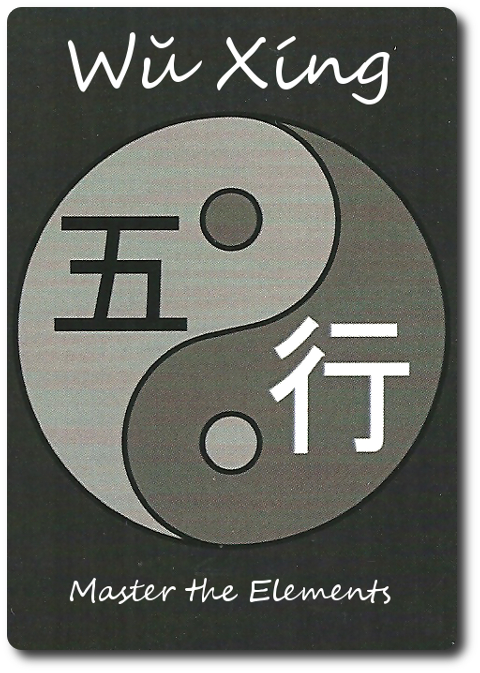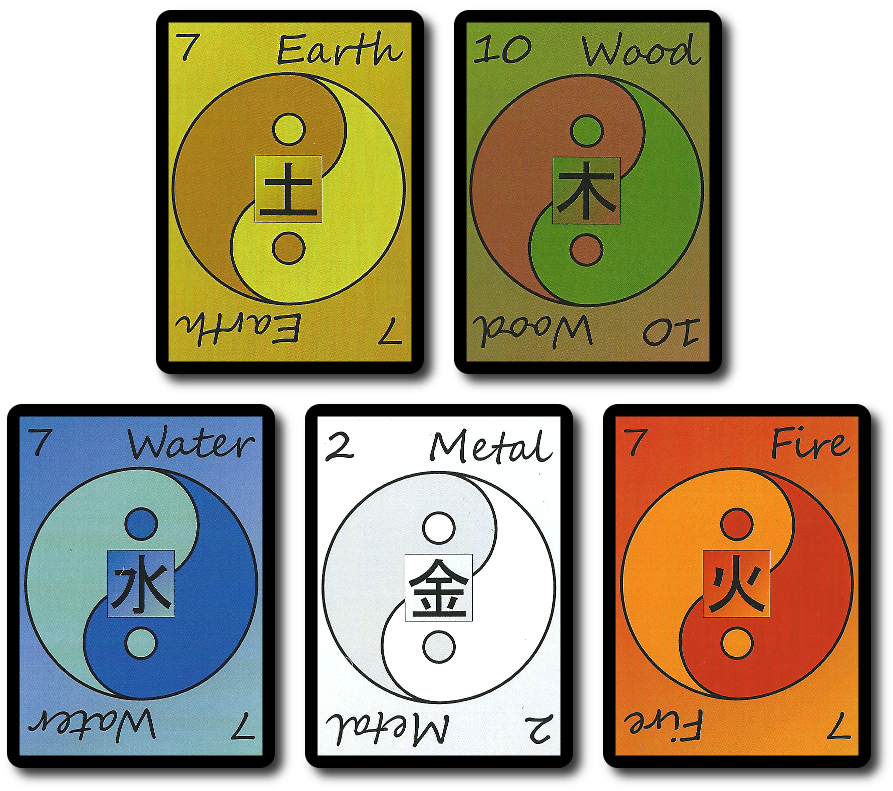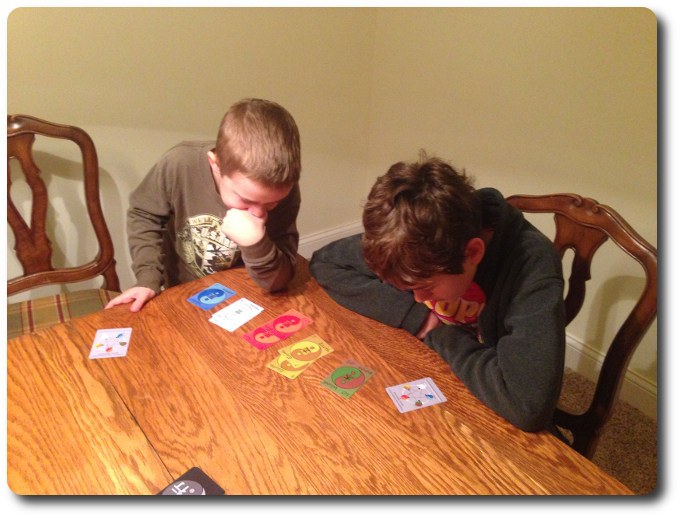
The Basics:
- For ages 8 and up (publisher suggests 12+)
- For 2 to 10 players
- Variable game play length
Geek Skills:
- Active Listening & Communication
- Counting & Math
- Logical & Critical Decision Making
- Pattern/Color Matching
- Strategy & Tactics
- Risk vs. Reward
- Semi-Cooperative & Team Play
- Hand/Resource Management
Learning Curve:
- Child – Easy
- Adult – Easy
Theme & Narrative:
- Balance the forces of Creation and Destruction
Endorsements:
- Gamer Geek approved!
- Parent Geek approved!
- Child Geek approved!
Overview
Chinese Taoist cosmology is structured around five elements that form the basic building blocks of everything around us. The act of creation and destruction begins and ends with these elements, putting them at the center of both the metaphysical and physical world for a practitioner of Taoism. In this game, victory will go to the player who can control the elemental forces.
Wŭ Xíng, designed by James Favier and published by Yellow Eyed Studio via the Game Crafter, is comprised of 100 Element cards (2 cards of each element with the values 1 through 10) and 5 Reference card. The cards are as thick and as durable as your standard playing card. The format of the card layout is easy to read and minimal in presentation. Color is used to identify the different card suits, but each suit is also clearly printed on each card, allowing those who have difficulty identify colors an easy method of playing without issue. Not included with the game, but necessary to play, is a pen or pencil and a pad of paper to keep track of players’ scores.
Elemental Education
The elements are individual parts of a single whole. They are all related and can be manipulated to alter other elements. As a student of the Elemental Arts, you need to know how the elements can be used. In game terms, each Elemental card can both create and destroy another Elemental card, which determines how the Element cards can be played.
There are 5 primary elements. These are Earth, Wood, Water, Metal, and Fire.

These elements can be used to create and destroy other elements. Creating elements is referred to as the “Creation Cycle”. Destroying elements is referred to as the “Destruction Cycle”.

Creation Cycle
- Fire creates Earth
- Earth creates Metal
- Metal creates Water
- Water creates Wood
- Wood creates Fire
Destruction Cycle
- Fire destroys Metal
- Metal destroys Wood
- Wood destroys Earth
- Earth destroys Water
- Water destroys Fire
During the game, players will be using both cycles in hopes of being the first player to place all their cards or to reduce the number of points an opponent will earn. Until the fairly straightforward Creation and Destruction Cycles are memorized, players should use the Reference cards.
Preparing for Your Trials
To set up the game, first remove the Reference cards and set them aside. These are handy for those who have never played the game before, but not necessary to use. Hand them out to each player as required and requested. Any Reference cards not used should be returned to the game box.
Second, determine who the first Dealer will be and pass them all the Element cards. The Dealer now shuffles and then deals 10 Element cards, face-down, to each player. Players should look at their cards, but keep them hidden from opponents until played.
Third, the Dealer places the remaining Element cards face-down in the middle of the playing area. This is the Element draw deck. The Dealer flips over the first Element card and places it next to the draw deck, face-up, to create the discard pile. If there is no draw deck, the Dealer plays any card from their hand to the middle of the playing area, face-up, to create the discard pile.
That’s it for game set up. The first player to the Dealer’s left goes first.
Mastering the Elements
Wŭ Xíng is played in rounds, turns, and phases. In total, there are 2 phases per round, but the number of turns per phase will depend on the number of players. A typical game round is summarized here.
Phase 1: Creation
During this phase of the game, each player will place 1 Element card to the discard pile that is the same Element and has a higher value than the previously placed card or place a card of the Element created by the face-up Element card of any value.
For example, if the previous player placed an Earth “6” Element card, the next player could place an Earth “7” Element card (being of the same Element and of a higher value) or a Metal Element card of any number value (since Earth creates Metal).
If a player is unable to place a card on their turn, they must draw 1 Elemental card and add it to their hand. If there are no cards to draw, the player skips their turn. If every player skips their turn, shuffles the discard pile to create a new draw deck.
This phase continues until 1 player is able to place all the cards in their hand. This individual is the “Master of the Hand”. They will now sit back and watch their opponents scramble for points.
Phase 2: Destruction
All players except the “Master of the Hand” will now participate in the second phase of the round. All Element cards the players have remaining in their hand are gathered, placed face-up, and organized by Element in front of all the players. This is referred to as the “players’ pool”. Players do not have a personal hand of Element cards during this phase of the game.
This phase is collaborative and the goal is to use the Element cards to remove as many Element cards as possible from the players’ pool. This is done by using the individual Element card’s destructive cycle and number values. Any cards the players cannot get rid of will benefit the Master of the Hand.
In essence, this is a bit like the card game Solitaire, but it’s a team effort. Players must use or destroy the entire number value of each Element card for it to be removed. Each Element card can only be used to destroy or be destroyed. Not both. This means each card can be only be used once.
For example, if the players want to destroy an Earth Element card with the value of 6, they could use 1 or more Wood Element cards with the combined number value of 6. Doing so would remove the Wood Element cards and the Earth Element card from the round. Removed cards are placed to the side in a single pile.
Phase 3: Scoring
After the players have determined that they can no longer use and destroy any cards, the scoring phase begins. The numeric values of all the Element cards that are still in play are added together by Element. Each individual Elemental value is given to the Master of the Hand. The other players score no additional points.
End of the Round and End of the Game
The round ends after scoring the remaining Element cards. The Master of the Hand collects all the Element cards and becomes the new Dealer for the next round.
The game ends when any player has earned 15 points for each of the 5 Elements. This player is the Master and has learned to manipulate the elements however they wish. The other players have to go get real jobs to make a living.
Game Variants
There are a few game variants available for those who want to change the game play without upsetting the game’s balance. Each are summarized here.
Target Point Challenge
The default number of points per element is 15 to win the game. However, a group of players can change that target number to a higher or lower value based on available time and desired game length. For example, reduce the total number of points per element to 5 for a fast and intense game or increase to 25 for a longer and more strategic game.
Overflow
This game variant allows the Master of the Hand to convert points earned for elements that already have enough points to other elements. Use the Creation Cycle to push points to the next element. For example, if the Master of the Hand had 15 Water element points and earned another 5, they could push the additional 5 points to the Wood element.
All Elements
Instead of keeping track of different elements, the game is played to a set number of total element points. For example, 100 element points that is comprised of all elements scored by the player.
To learn more about Wŭ Xíng, visit the game’s web page on the Game Crafter.
Final Word
The Child Geeks had no problem learning how to play Wŭ Xíng. In some respects, it has the same game mechanics that are common to most Card games. Specifically, suits and number values. What the Child Geeks had problems with at first were the Creation and Destruction Cycles. The Reference cards proved to be an invaluable resource and helped guide the Child Geeks, keeping the games going and the player’s happy. According to one Child Geek, “What I like about this game is that there are different stages you have to think about. I’m racing to win, but I don’t want to be stuck with cards I cannot use.” The Creation and Destruction Cycles were met with a great deal of enthusiasms by the Child Geeks. When I asked why, one Child Geek responded, “It just feels different and interesting each time. Makes it fun and challenging.” It was something like a puzzle and the Child Geeks liked that the first portion of the game was played competitively and then the second was semi-cooperative. The Child Geeks never felt left out or let down, resulting in the game’s unanimous approval from these young Elemental Masters.

My two oldest combine their forces to reduce the number of Element cards that will be mine…
The Parent Geeks were also impressed with the game. The casual and non-gamers where the most excited about Wŭ Xíng, but even the more experienced Parent Geeks enjoyed themselves. According to one such Parent Geek, “I’m not really big on plain old card games, but I’d play this again. I really like how the game shifts gears and changes the game play from everyone versus everyone to everyone versus one.” A casual Parent Geek said, “The game is very intuitive and challenging. Fast, too. I’m really enjoying it.” All the Parent Geeks enjoyed Wŭ Xíng with both family and friends, as well as with just their peers. When all the elements were captured (or destroyed), the Parent Geeks voted to approve the game.
The Gamer Geek felt that Wŭ Xíng was just slightly more than Rock-Paper-Scissors. According to one Gamer Geek, “A clever concept and I like how the game designer uses the cards, but the overall game is not one I found that challenging, but I did have fun.” Another Gamer Geek said, “Despite there being a bit of Rock-Paper-Scissors in this game, which I hate, I was pleased with the game’s level of depth and strategy.” In fact, all our Gamer Geeks found Wŭ Xíng to be a game they enjoyed, despite a few of them not being able to really say wise. The end result was a game that the Gamer Geeks all agreed would make for an enjoyable filler, or at the very least, a game they would gladly play with non-gamers.
Wŭ Xíng was a real surprise. The game play is exceedingly straightforward to a point where I was certain it would put our players to sleep. The truth is, the simple game play hides the game’s real nature. The Creation phase of the game is not a race, but an exercise in positioning. If a player goes out too fast, they leave their opponents with a lot of cards to use, making it easier to remove cards in the process. But if the player goes out too late, they reduce the total number of points they have available to them. Additionally, the player wants to control which Element cards are in play so they can focus on obtaining points for those elements they require. That’s a lot to think about and our more experienced players had a great deal of fun attempting to manipulate the first phase of the game. Some succeeded while others failed miserably.
The Destruction phase is an opportunity for common enemies to form a temporary alliance to redeem themselves and reduce the number of points their common foe can earn. The old adage, “my enemy’s enemy is my friend” comes into play, and players must work together. I was concerned that this shift would feel unnatural, but to the contrary, it was a welcomed change. Now the players were able to team up, work together, and take turns ganging up on one another. It created a lot of interesting moments and a lot of fun.
I do not suggest you play this game with anymore than 5 players. The total game length gets ridiculously long (around 2 hours) when playing with so many individuals. Of course, the game can play up to 10 players without issue, but if you choose to do so, then I suggest you use the “All Elements” alternative method of keeping score. This will allow players to score each hand every round, making the game’s length slightly less long. Emphasis on the “slightly”.
Wŭ Xíng combines a number of traditional and familiar game playing mechanics, but manages to present itself in a way that feels fresh. While the game did not break any new ground, it was most certainly built upon the five elemental pillars of a successful game: fun, engaging, strategic, tactical, and interactive. Do play Wŭ Xíng if the opportunity presents itself.
This game was given to Father Geek as a review copy. Father Geek was not paid, bribed, wined, dined, or threatened in vain hopes of influencing this review. Such is the statuesque and legendary integrity of Father Geek.
Discover more from Father Geek
Subscribe to get the latest posts sent to your email.






Thanks for the review Father Geek! This floored me, and you have put me in a good mood.
You are most welcome. Congratulations on designing a game that appealed to a wide audience.